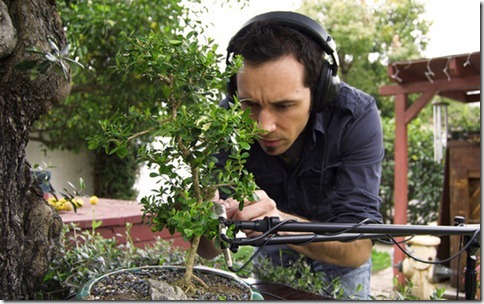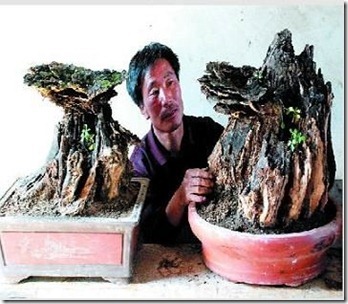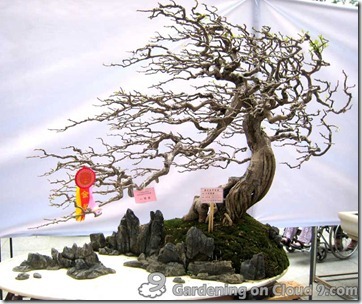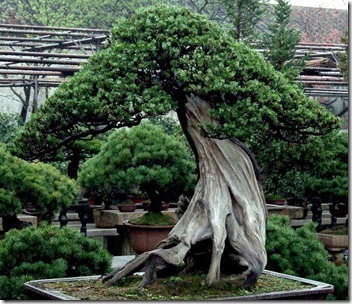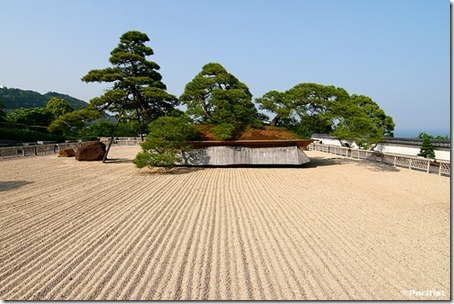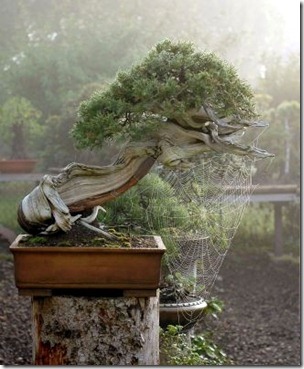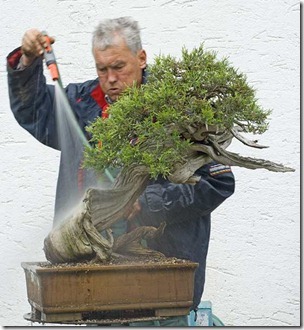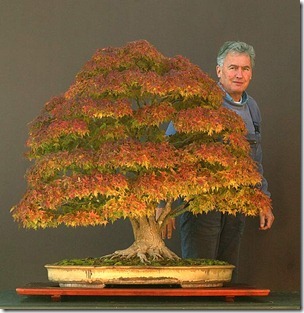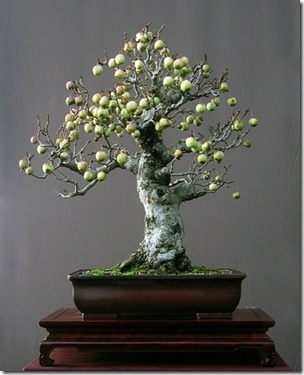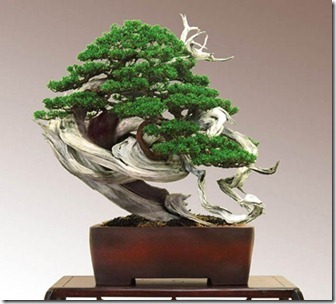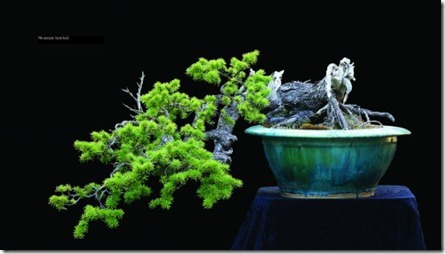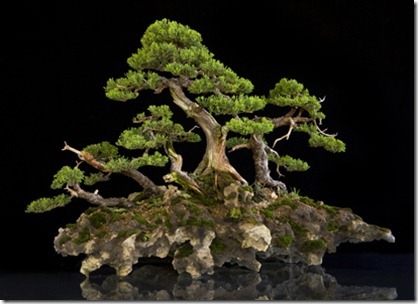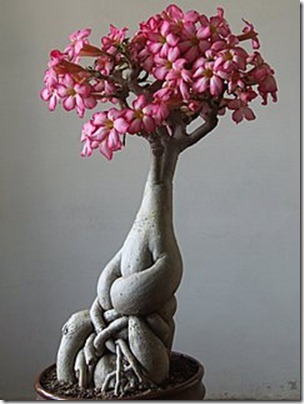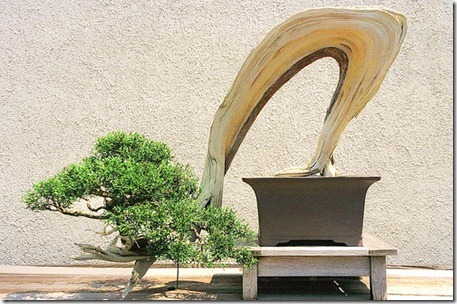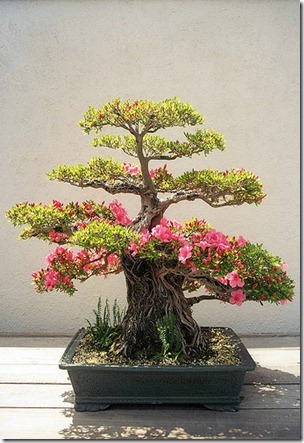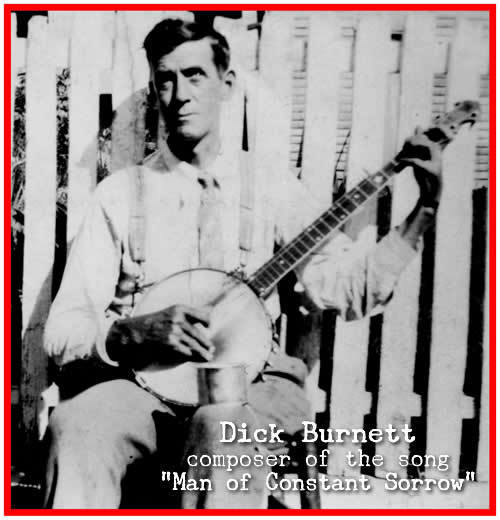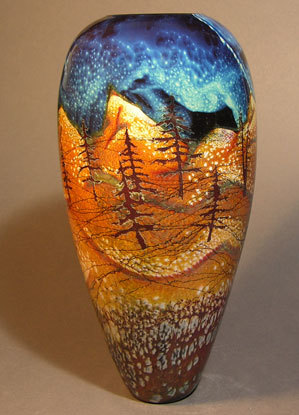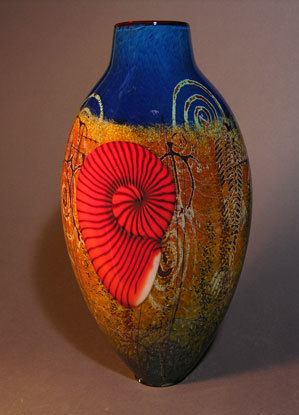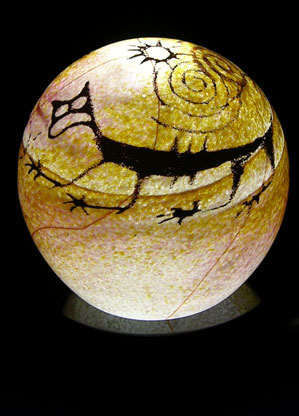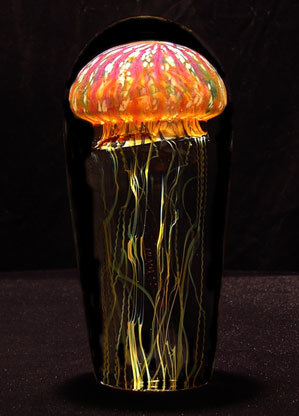Lawrence R. Spencer's Blog, page 94
May 10, 2022
15 Best Bonsai Trees
Republished by Blog Post Promoter
Bonsai literally means “plant in a tray” in Japanese and it seams that the tree and the pot form an unique harmonious unit where the shape, texture and colour of one, compliments the other. To obtain a harmonious bonsai can take dozens of years of pruning, wiring, leaf trimming, clamping and grafting. Some of the specimens featured here are faithful to the Japanese aesthetics and philosophy, while some growers made a real effort to get out of the box…arr, tray.1. World’s Smallest Bonsai Tree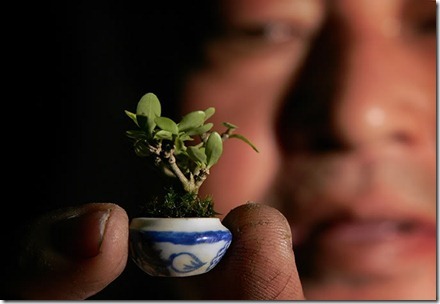 What’s smaller than a miniature tree? A miniature miniature tree. This masterpiece measures 22mm and it was obtained from a Malaysian local species called “water jasmine” – the only species that can apparently be made so small. Creator Kuah Tee Teong claims that it may be the world’s smallest bonsai, since the standard measure of a miniature bonsai is 10cm. Kuah doesn’t strive for popularity and didn’t register his creation in the Worlds Book of records, neither is he planning to sell his tiny trees. His philosophy: ‘’If I sell, then I’ll have nothing to show.” He also prunes animal shaped trees that look like dogs, snails or octopuses.
What’s smaller than a miniature tree? A miniature miniature tree. This masterpiece measures 22mm and it was obtained from a Malaysian local species called “water jasmine” – the only species that can apparently be made so small. Creator Kuah Tee Teong claims that it may be the world’s smallest bonsai, since the standard measure of a miniature bonsai is 10cm. Kuah doesn’t strive for popularity and didn’t register his creation in the Worlds Book of records, neither is he planning to sell his tiny trees. His philosophy: ‘’If I sell, then I’ll have nothing to show.” He also prunes animal shaped trees that look like dogs, snails or octopuses.
Diego Stocco is not a bonsai grower, hasn’t won any bonsai competition award, but he is, in his own unique way, a bonsai lover and tamer. He bought a bonsai tree and made it sing, proving that you actually can teach an old bonsai new tricks. Using a Røde NT6 microphone, some tiny transducers and a customized stethoscope, Stocco recorded an experimental piece played exclusively by the bonsai’s small leaves and branches. He also used a piano hammer, a paint brush and different bows to obtain different sounds from the tree. Don’t be scandalised if it seams from this video that he is somehow torturing the poor little tree. No bonsai was damaged during the experiment and, as you know, art demands sacrifices.
3. Rare Ganoderma BonsaiThis is an extremely rare ganoderma lucidum cultivated bonsai, with an impressive diameter of 90cm. The successive layers and crown shaped cap make it unique in the world.
Known as “”fairy herb”, Gandorema lucidum has been used for medicinal purposes in traditional Chinese medicine for more than 2000 years. It is one of the oldest mushrooms to have been used in disease treatments and , due to it’s presumed health benefits and apparent absence of side effects, it is known as one of the most powerful herbal substance in East Asia. In Chinese culture, it is also considered a good luck, beauty and longevity charm. The plants health benefits and spectacular shapes and colours saved it an important place on the bonsai market as well.
“Penjing” is the Chinese extension of bonsai art and it can be literally translated “landscape in a pot”’. The chines art focuses more on creating a convincing miniature landscape than shaping the perfect miniature tree as Japanese bonsai growers strive to obtain. Nonetheless, the value of an awarded penjing is given by the way it looks with naked branches, when not attired in fabled leaves and flowers. The assembly in the image is called 大風驚濤, which literally means “harsh wind severe waves” and it was awarded at the Guangzhou Penjing Exhibition in China, the biggest lingnan (southern style) penjing exhibition since the founding of the country.
5. The Oldest Bonsai TreesThe oldest known bonsai trees still living can be found in a private restaurant garden in Tokyo, Japan. The 400 to 800 years old trees in Happo-en Garden ar an attraction for any bonsai lover visiting Tokyo. Every tree is grown in era-specific pots that are often as valuable as the trees themselves.
The practice of potted trees gose way back to the Egyptian Era, 4000 B.C. Inhareted images depict miniature trees cultivated in rock containers. Pharaoh Ramesses III is known to have donated several olive trees and other miniature plants to various temples. In the Indian Pre-Common Era several plant species were grown in a “”bonsai manner” for medicine and nutrition purposes.
6. World’s Biggest Bonsai TreeThis 600 year old Japanese bonsai is presumably the biggest bonsai tree in the world, according to the staff of Akao Herb & Rose Garden in Atami, Japan. Sure, the title is somehow paradoxical since the main quality of bonsai trees is being small. But, after all, if bonsai means “tree in a pot” it doesn’t metter how big the pot is, especially if it contains an impressing 5 meter tall and 10 meter wide ancient red pine bonsai like this one.
7. Walter Pall’s Rocky Mountain JuniperWalter Pall is a kind of bonsai rock-star among the culture’s enthusiasts. He has received several dozens national and international awards for his beautiful, dramatic bonsai. He has won the most prestigious Crespi Cup Award of Italy for his well known Rocky Mountain Juniper, and has come in among the top six, every time he has entered. He has also won second and third and other places places in the Gingko Cup Awards of the Belgium bonsai competition held every two years. The most controversial information about Walter pall is that, although world renown, he considers himself an amateur working professionally. That’s because he styles trees for his own amusement and not for commercial purposes. In time he managed to put together one of the most comprehensive bonsai collections around.
8. Walter Pall’s Acer PlatanusAnother famous piece from Walter pall’s collection is this Sycamore Maple that won the Bonsai Today / Art of Bonsai Photo Contest. Pall was one of the first Europeans to work with indigenous species, which he collects in his beloved Alpine mountain.s He now owns a collection of about 1000 quality trees in varying stages of development and keeps a store reserve of about 1000 handmade pots to compliment the bonsai. Besides his famous conifers he is also well known for his beautiful deciduous trees. Walter’s bonsai usually are strong, powerful trees which he frequently forms in natural shapes. The longer he has been involved with tree development, the more he has moved away from traditional bonsai styling to his own concepts of design.
9. Walter Pall’s Crab Apple TreeThis is my personal favourite from Pall’s collection: an incredibly sweet 65 cm high apple tree. I have no idea how anyone that sees it live could resist not to taste those tiny apples, but I guess Mr. Pall keeps it in a safe place, away from leering guests. Fruit trees training is an ascending trend among bonsai growers. The fascinating part about it is that the fruits are indeed edible, especially those belonging to the citrus category. Common fruits that can be obtained in small size include: cherries, apples, lime, lemons, tangerine and figs. The bonsai fruit tree success strongly depends on meteorological and topographical factors, like humidity, temperature and soil.
10. Awarded Chinese Juniper “Itoi-gawa”The Chines Juniper is a very loved and popular tree among bonsai professionals and amateurs alike. Due to the woods malleability, it can be stylised into beautiful and interesting shapes. Like this one belonging to Enrico Savini from Italy, that has won several awards, including Ben Oki International Design Award in 2003 and Bonsai Clubs International People’s Choise Award 2008. Savini says he fell in love with bonsai art at age ten and his first tree, a Prunus mume that only survived a few months, was a gift from his grandma. “ I couldn’t forgive myself for that failure, so I took it as a personal challenge, my entire career has been a continuous personal challenge.”
11. Dan Robinson, The Picasso of BonsaiThis perfect Mountain hemlock expresses Dan Robinson’s virtuosity as a bonsai artist and his respect for the nature’s own ways. Known as a pioneer in bonsai art, or as the Picasso of bonsai, he practices an preaches techniques inspired by the ancient Japanese ways. This is one of the many amazing captures pictured in the book Gnarly Branches, Ancient Trees: The Life and Works of Dan Robinson – Bonsai Pioneer made ]n collaboration with photographer Will Hiltz.
12. Awarded Junipero San JoseThis work of art belongs to Nacho Marin, a Venezuelan Fine Arts graduate who is fascinated by the infinite possibilities of taming and manipulating trees. In his quest to recreate a natural environment, he also takes great care so that the shape and mood of the final product reflects his artistic vision. No wonder that his Junipero San Jose won the flattering title of ”Most artistically innovative entry of all entries from all categories” at The Art of Bonsai Contest 2008.
13. Adenium Flower BonsaiNot as popular as junipers, but unanimously loved for their delicacy and frailness, flower bonsais can come up in extraordinary forms. Mr. Jai Krishna Agarwal from india has about 100 specimens in his collections and he especially loves adenium flowers. Why? Because their trunks often remind the shapes of the human body . The effect is surrealistic to say the least, this beautiful example shown here brings to mind some elaborate fauvist sculpture.
14. Semi-cascade Juniper BonsaiA Juniper bonsai collected, designed and developed by Harry Hirao and displayed at the National Bonsai and Penjing Mueseum at The United States National Arboretum. This very old, semi-cascade style bonsai was probably collected in the White Mountains of California. The shari (deadwood on the trunk) is very prominent on this bonsai, leaving only one stripe where the tree is connected between its leaves and the roots.
The esthetics behind this type of contorted and twisted trunk is called literati and it was influenced by the political and academic conditions in the Tang Dynasty period, when penjing was once widely practiced by the elites. Literati is a contemplative, lyrical style displaying tension (in the trunk) and release (in the cascading branches) like the universal law of Yin and Yang.
15. Beautiful Azalea TreeAn old Azalea, probably a Satsuki type, from the Collection of the National Bonsai and Penjing Mueseum at The United States National Arboretum. Azaleas bloom in spring, their flowers often lasting several weeks. In Chinese culture, the azalea is known as “thinking of home bush” (xiangsi shu) and is immortalized in old poetry and contemporary stories.
May 9, 2022
MAN OF CONSTANT SORROW
Republished by Blog Post Promoter
MAN OF CONSTANT SORROW is one of my favorite songs. It communicates the very real pain that all of the citizens of our Earthly prison experience, to a greater or lesser degree. The song was originally recorded by Burnett as “Farewell Song” printed in a Richard Burnett songbook, c. 1913.
Written by Richard (Dick) Burnett (October 8, 1883 – January 23, 1977) was an American folk songwriter from Kentucky. Burnett was born near Monticello, Kentucky. He was known to play the banjo and guitar and was blind in one eye. Burnett allegedly wrote the traditional American folk song, Man of Constant Sorrow, which was later to be covered by Bob Dylan. He recorded with fiddler Leon Rutherford for Columbia Records. An early version was recorded by Emry Arthur in 1928.
The following are subsequent “covers” of the song:
Ralph Stanley (Solo version (cover)) http://youtu.be/fLKltv26-00
Stanley Brothers (cover) http://youtu.be/ldnZnjGBGXw
Original Lyrics to “Farewell Song” (Man of Constant Sorrow)
I am a man of constant sorrow,
I’ve seen trouble all of my days;
I’ll bid farewell to old Kentucky,
The place where I was born and raised.
Oh, six long year [sic] I’ve been blind, friends.
My pleasures here on earth are done,
In this world I have to ramble,
For I have no parents to help me now.
So fare you well my own true lover,
I fear I never see you again,
For I’m bound to ride the Northern railroad,
Perhaps I’ll die upon the train.
Oh, you may bury me in some deep valley,
For many year [sic] there I may lay.
Oh, when you’re dreaming while you’re slumbering
While I am sleeping in the clay.
Oh, fare you well to my native country,
The place where I have loved so well,
For I have all kinds of trouble,
In this vain world no tongue can tell.
Dear friends, although I may be a stranger,
My face you may never see no more;
But there’s a promise that is given,
Where we can meet on that beautiful shore.
________________________________________________
Dick Burnett Biography on Wikipedia.org
Burnett was born near Monticello, Kentucky. He was known to play the banjo and guitar and was blind in one eye. Burnett was born near the end of the nineteenth century on October 8, 1883, in the area around the head of Elk Springs, about seven miles north of Monticello. He remembered little of his farming parents. His father died when he was only four and his mother died when he was twelve. Burnett did say that his mother told him how his father would carry him in his arms when he was only four years old and he would help his dad sing. It is notable that Burnett’s grandparents were of German and English descent and that particular ancestral influence would be instrumental in forming Burnett’s musical career. At seven-years-old, Burnett was playing the dulcimer; at nine he was playing the banjo, and at thirteen he had learned to play the fiddle.
Richard Burnett’s life took a drastic turn in early adulthood when he was attacked by a robber, shot in the face, and lost his eyesight. He was working in the oil field of central Kentucky, married with a young child, and now faced an uncertain future. Almost prophetically, his boss made the following statement to Burnett: “Well, you can still make it; you can make it with your music.”
In time, Burnett joined forces with a young fourteen-year-old orphaned boy from Somerset. That young boy, Leonard Rutherford, would become Burnett’s student and became one of the “smoothest” fiddle players known to come from Kentucky.
Richard Burnett, “blind minstrel of Monticello” and Leonard Rutherford, “one of the smoothest fiddlers ever to take a bow,” soon were singing at every opportunity. They appeared on courthouse lawns and on the street playing and singing their music. In order to earn some money, Richard would strap a tin cup to his knee to collect the contributions from a satisfied crowd.
They traveled by bus, Model A, and on foot to any place they could and sing. From about 1914 until 1950, the pair became so popular that they found themselves in the company of most all the popular mountain musicians of the time. They were “at home” in the presence of greats like the Carter Family, Charlie Oaks, Arthur Smith, and many others. They appeared at the Renfro Valley Barn Dance, on radio stations in Cincinnati, and finally, they would be some of the first old-time musicians to enter the recording studios.
Burnett and Rutherford made their first commercial recording in 1926 for Columbia Records in Atlanta, Georgia. “They gave us sixty dollars a record and paid all our expenses from here to Atlanta and back, hotel bills and everything,” Burnett reminisced. This unique banjo-fiddle-playing team, at times joined by banjoist W.L. Gregory and his fiddle-playing brother Jim, also of Monticello, continued to record for Columbia (and Gennett as well), through 1930.
Many of the songs Burnett and Rutherford used in their performances were songs they had learned from others in the past. When Burnett was asked where he learned some the old songs he recorded, he indicated some of them came from “Negroes around playing old time music” in Wayne County. He mentioned “Bled Coffey here in town, he was a fiddler during the Civil War, and the Bertram boys here, Cooge Bertram was a good fiddler…..Yes sir, there were a lot of black men playing old-time music. Bled Coffey was the best fiddler in the country.”
Burnett was a prolific songwriter as well as an instrumentalist. Possibly his most well known song is the popular “Man Of Constant Sorrow” that found notoriety in the movie, “O Brother, Where Art Thou.” On one occasion when asked if he wrote the song, Burnett replied: “No, I think I got that ballet from somebody—I dunno. It may be my song…..”
It has been correctly observed about Richard Burnett: “He was a valuable link to country music’s folk past and was a repository of material which he had both preserved and rewritten: “Pearl Bryan,” “Short Life of Trouble,” “Weeping Willow Tree,” “Little Stream of Whisky,” and many other ballads known to all folk revivalists.” The team certainly deserves the title of “one of the most colorful and rewarding groups of the 1920s.”
Richard Burnett died in Somerset, Kentucky on January 23, 1977, probably without ever realizing the great influence he had in the field of old-time Appalachian music.
18 THINGS PEOPLE DON’T TALK ABOUT ANY MORE
Republished by Blog Post Promoter
18 Things People Don’t Talk About (much) any more:
1. pregnant men in prison
2. how you feel about being God
3. watching your parents conceive you
4. intentionally shitting yourself at work
5. where you’re hiding the dead bodies
6. mud and maggot sandwiches
7. intermural projectile vomiting contests
8. having oral sex in heaven
9. your fantacies about kitten livers
10. absolute nothingness forever
11. pretending to be the perfect human
12. how perfect your ______ is
13. what you did before time began
14. your gourmet cockroach recipes
15. bribes you were paid to stay quiet
16. that “thing” you did with ________
17. how much nicer you are than Jesus
18. priests alone with young boys
DREAM BY DAY
Republished by Blog Post Promoter
“Those who dream by day are cognizant of many things which escape those who dream only by night.” — Edgar Alan Poe
May 8, 2022
May 7, 2022
HUMAN FOOD
Republished by Blog Post Promoter
Yummy and delicious! Wholesome and nutritious! Ready to roast, bake, fry or filet! Try it today!

THE NEXT WORLD
Republished by Blog Post Promoter
PLATO — 348/347 BC) was a Classical Greek philosopher, mathematician, student of Socrates, writer of philosophical dialogues, and founder of the Academy in Athens, the first institution of higher learning in the Western world. Along with his mentor, Socrates, and his student, Aristotle, Plato helped to lay the foundations of Western philosophy and science.[3] In the words of A. N. Whitehead:
“The safest general characterization of the European philosophical tradition is that it consists of a series of footnotes to Plato. I do not mean the systematic scheme of thought which scholars have doubtfully extracted from his writings. I allude to the wealth of general ideas scattered through them.“
Plato’s sophistication as a writer is evident in his Socratic dialogues; thirty-six dialogues and thirteen letters have been ascribed to him. Plato’s writings have been published in several fashions; this has led to several conventions regarding the naming and referencing of Plato’s texts.[5] Plato’s dialogues have been used to teach a range of subjects, including philosophy, logic, ethics, rhetoric, and mathematics. Plato is one of the most important founding figures in Western philosophy. — Wikipedia.org
Satava Art Glass
Republished by Blog Post Promoter
I have a life-long fascination with glass blowing and glass art. Glass blowing is a trade and art form that is rapidly disappearing from the world. Fortunately, I had the privilege of touring the Satava artistic glass studio today. The studio is located in the quiet village of Chico, CA. Each hand-blown work of art glass is designed by Satava himself who supervises a veteran crew of 4 or 5 master glass blowers. Visit the website for a complete list of galleries who feature these extraordinary master works of glass art.
Satava Hand-Blown Glass Vases
Satava hand-blow glass vases are each entirely original works of glass art. One can only really appreciate the stunning colors and unique design by seeing them in person.
Satava Hand-blown glass paper weights
Satava Hand-blown glass “jellyfish” globes are astonishingly beautiful in person. Each glass globe takes a team of 4 or 5 glass artists more than 2 hours to produce.
Visit the Satava website for more: Jellyfish : Satava Art Glass.

